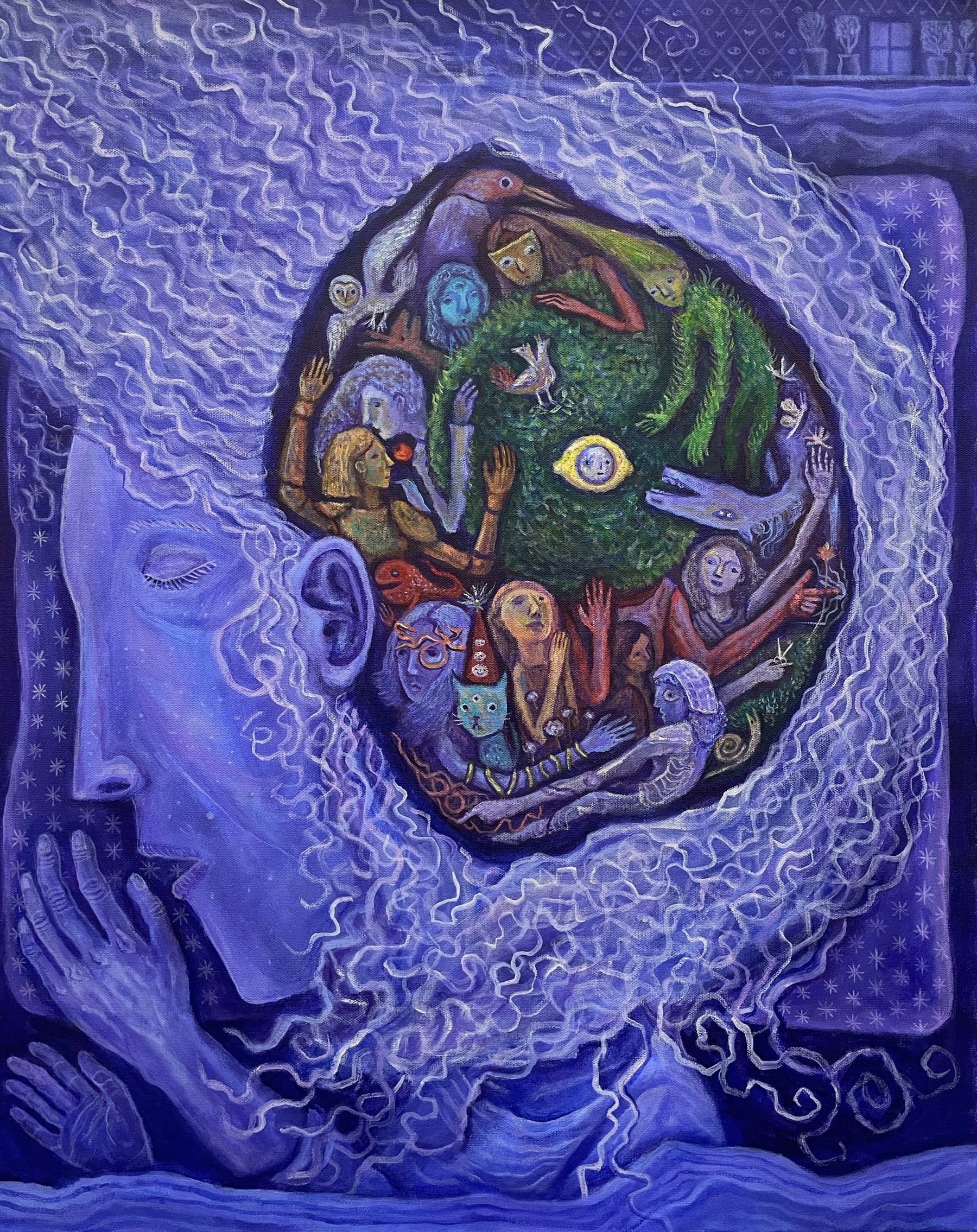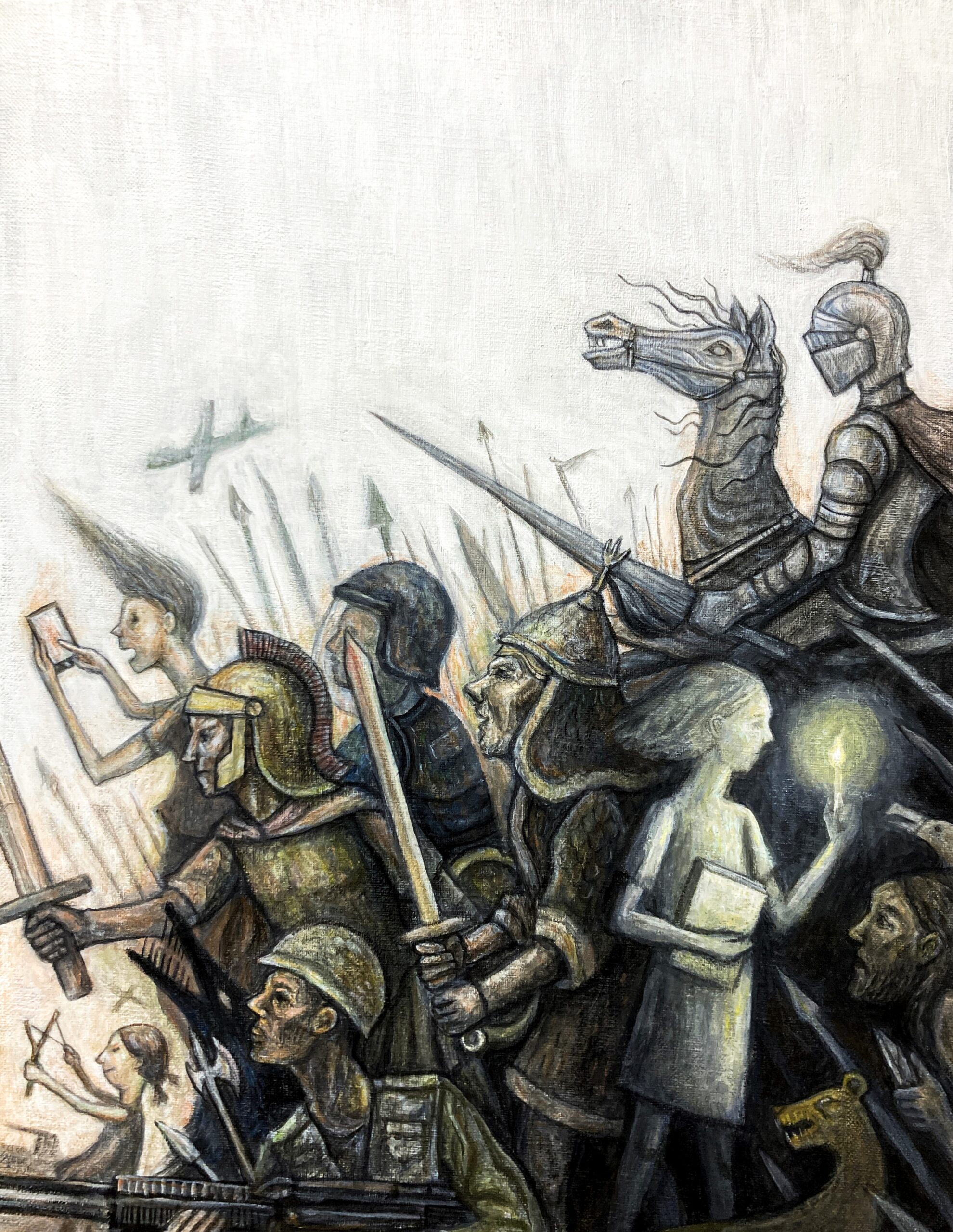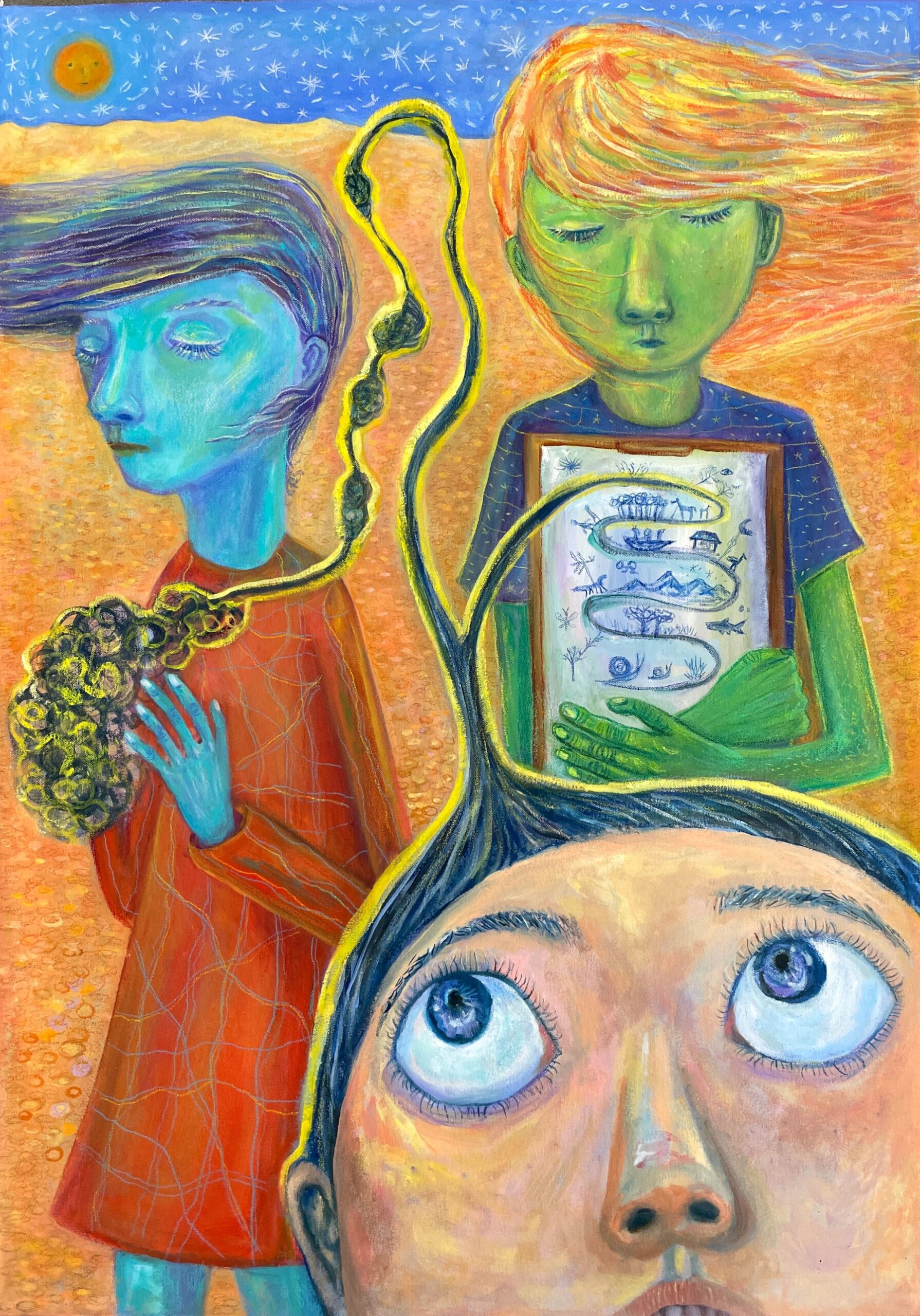
Fantastic Solipsistic,2023, inspired by Prof. Rebecca Copenhaver, by Becky Moon (Courtesy of Becky Moon)
Done right, philosophy is as charming, irritating, and deliberately provocative as a toddler asking, “But why? Why? Why?” Yet too often it is presented only in rigid black letters, a gray page of text stripped of imagination, the ideas a strain to visualize.
Becky Moon intends to change that.
She started as a political activist, gathering sixty thousand signatures while she was still in high school in South Korea. The petition would criminalize the purchase of cameras hidden in bathrooms and hotels to spy on women, an immorality that outraged her. Moon’s father was a lawyer, and I can easily imagine him watching with pride and urging her toward a law career. Except, he was also a philosopher, specializing in the philosophy of law. “Hard powers like laws are not the only ways you can change someone,” he reminded her. “Change starts small, with the way people perceive the world.”
After one of their long conversations, she realized that art—a talent she had nudged to the side—was a powerfully human project, capable of moving people in a way syllogisms could not. She chose Washington University—“the first university-affiliated art school in the United States,” she says proudly—because its visual education took up six buildings, not just the few floors that most universities devoted. Also, WashU had a strong philosophy department, a separate, perhaps congenital interest that she assumed was unrelated.
Moon began her freshman year in the middle of the pandemic. Home in Seoul, she assumed she had to dress for class, so at 11:30 p.m. Korean time, she buttoned up a white shirt and sat down at her laptop for ethics class. “Hello, Professor!” she says now, mimicking that eager freshman naivete. She soon relaxed her dress code—but not her mind. She was stunned to hear how much research was being done, how “every nook and cranny of morality was being debated.” This was far more exciting than the cover of her textbook: a bright blue blob.
Is there any way to make books like this look a little more pop, a little more trendy? she wondered, hoisting the book. Philosophy needed some rebranding, if people were not to relegate it to grumpy old men. But she was just a freshman, so she shrugged off the question and contented herself with doodling fresh, playful little pictures about the thought experiments. She had an artist’s version of synesthesia, her imagination supplying instant images for every abstract idea she encountered.
I flash back to my philosophy textbooks, which had not even reached the modern color-block stage. Most offered black-and-white photographs of marble busts of the ancients, cold and bloodless. Surely the love of wisdom could conjure more vivid images? The solemnity of the discipline, back then almost entirely male, sometimes felt arrogant, like ego so stiff it refused to bend or play. Heavyweight authors resigned themselves to writing tomes that would either be bought by the inner circle of fellow philosophers or assigned and obligatory, with no need to intrigue. Yet these books touched the core of all our lives.
Moon’s next philosophy course explored art, perception, and the mind-brain, exploding what she had assumed were philosophy’s boundaries. “Then I took existentialism,” she says, “and I cried every class. It was as if the philosophers were telling me that I mattered as an individual.”
Working from her doodles, she began to illustrate philosophical concepts more fully. One of her philosophy professors, Becko Copenhaver, was also an art connoisseur, and when she saw Moon’s work, she suggested she do a show. Moon expanded the idea to a group show, with nineteen artists each picking a female philosopher and letting her work inspire them. Her choice was Heisook Kim, former president of the Korean Philosophical Association and Ewha Womans University, the largest women’s university in the world.
“Academic philosophy has rarely been the inspiration for artists,” Moon realized, puzzled by the void. “I feel like if I paint the concepts, I can let people know that these ideas are imaginable, they can be visualized. And having something turned into art immediately makes it fun.” Delivered to the senses, the ideas are given shape and warmth, color and life and possibility.
Her next challenge was a cover for the Washington University Review of Philosophy, a theme issue about the philosophy of war and violence. She positioned a group of soldiers from different eras, huddled close and all facing the same way, brandishing swords and bows and arrows. Within the charcoal darkness of their clash, a young woman faced the other way, holding a book and a candle. One of the contributors, Harvard professor Susanna Siegel, wrote to the editor to express her appreciation for the image.

The Philosophy of War and Violence, cover illustration for the Washington University Review of Philosophy, by Becky Moon (Courtesy of Becky Moon)
Moon was blown away. She had written many essays about Siegel, one of the most important scholars in the philosophy of perception. Emboldened by the compliment, she wrote to ask if Siegel would be interested in collaborating, with Moon giving visual form to her ideas.
Yes, absolutely.
Now Moon could set Kierkegaard and the other O.G.s aside and work with a living philosopher, someone who could answer her questions as she imagined the visuals. She spent her junior year turning Siegel’s philosophical arguments into art. Thinking about Siegel’s analysis of the constant interaction between our mind and the surrounding world, Moon was flooded by periwinkle and aqua, visualizing the ebb and flow as a sea of perception. When Siegel contrasted telic explorations (those with a firm purpose) and atelic (those done for their own sake, with no preordained goal), Moon envisioned “Wandering Inquiry,” an oil painting of two women gathering their long hair. One woman’s tresses weave themselves into a map; the other’s separate into loops and coils of yarn.

Wandering Inquiry, by Becky Moon, inspired by Prof. Susanna Siegel (Courtesy of Becky Moon)
Zachary Irving, a philosophy professor at the University of Virginia, emailed Moon with delight. Had she realized how apt her use of yarn was? “Around the turn of the 20th century, one word for mind-wandering was ‘wool-gathering,’” he explained. Virginia Woolf had criticized this sexist term for knitters idly gathering wool strands, a typically female pursuit dismissed because it was not rational or powerful—when in fact it was the start of creativity.
After graduation this spring, Moon is headed for a residency at the New York Academy of Art. At the moment, she is working on commissions from philosophy profs at Purdue and Notre Dame to make art for upcoming conferences, one on the philosophy of memory, the other on intellectual humility. She just finished illustrating a children’s book inspired by Iris Murdoch’s emphasis on “just and loving attention.” Her paintings for Siegel went on display at Harvard last year, and the collaboration continues: Siegel’s latest project, about vigilantes’ pursuit of justice, is already conjuring images.
Meanwhile, Moon has taken time out to foster a sweet, shattered pup who was rescued from horrific conditions. Morality shows up everywhere. The challenge is making it visible.
Read more by Jeannette Cooperman here.
